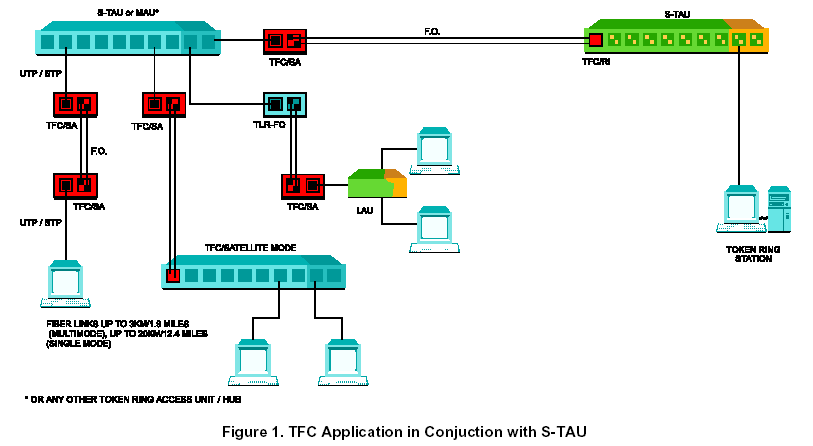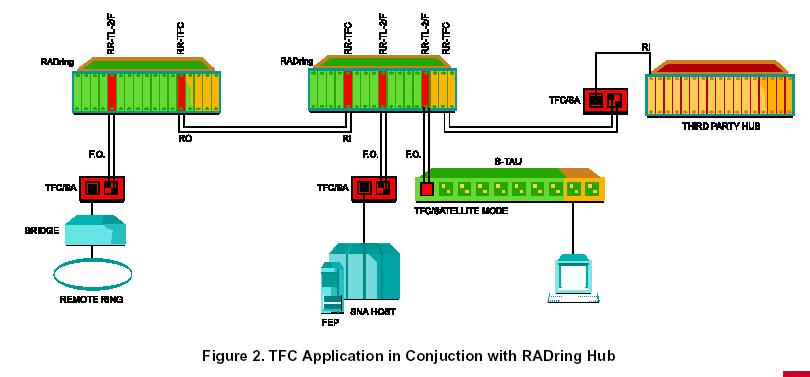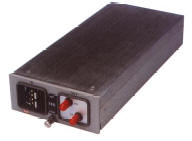|
FEATURES
- TFC, Token Ring Fiber Optic Converter, provides
electrical-to-optical and optical-to-electrical conversion of an IEEE
802.5 signal, for communication over an optical link. Transmission
distance can be up to 3 km (1.9 miles) for multimode and 20 km (12.4
miles) for single mode.
- An infrared LED transmitter converts the IEEE 802.5
electrical signal into an optical signal. At the receiver end, the optical
signal is converted back into an electrical signal.
- TFC can be operated in various modes:
- RI/RO mode: connects between adjacent Token Ring access units, such as
S-TAUs via a fiber optic link
- Lobe mode: converts the copper lobes of any access unit/hub to fiber
lobes
- Station mode: connects station to the optical lobes of the RADring
TL-2/F module
- Satellite mode: connects workgroups over a single fiber connection.
- In Station mode, the insert/bypass command,
originating at the Token Ring Adapter card in the form of a "phantom"
current, is carried through the fiber using special signaling.
- TFC is available in two versions:
- Stand-alone unit (TFC-SA)
- Card for installation in S-TAU (TFC)
TFC can also be installed as a module in the RADring hub (RR-TFC). (See
the RR-TFC data sheet for additional details).
- The stand-alone model has an integral power supply.
The
stand-alone unit is wall-mountable using the TR-WM brackets, or can be
mounted in a 19" rack using the TR-RM hardware. This hardware can support
up to four TFC units (see Ordering).
- Multimode or single mode fiber optic options are
available for both the stand-alone and the S-TAU card versions. In
addition, an internal media filter is provided for the UTP option.
- The TFC card for S-TAU is installed in the Ring In
or Ring Out port of the Access Unit. The card is powered by a
wall-mounted, external power supply. TFC provides an optical link between
two S-TAUs. Alternatively, for start topology, the TFC card can provide an
optical link between the lobe of a RADring and the Ring In port of another
S-TAU.
- Where retiming and jitter attenuation are required,
the TFC operates with the TLR-FO for lobe conversion.
- Fail-safe operation is provided by performing an
automatic loop to the backup path, upon power off detection or optical
signal loss detection.
- Indicators include power on and fault indication
for optical signal loss condition.
SPECIFICATIONS
- Provides conversion between electrical and
optical Token Ring signals
- Compatible with IEEE 802.5
- Operates at 4 and 16 Mbps
- Typical optical distances supported:
- 3 km (1.9 miles) multimode
- 20 km (12.4 miles) single mode
- Two versions:
- Stand-alone
-Card version for S-TAU
- Wide range of applications:
- RI/RO mode for optical trunk
- Lobe mode for optical lobes
- Station mode for station connection over fiber optic
- Satellite mode for workgroups
- Partitions the network upon cable break
- Provides noise immunity, electrical isolation
and security
- Supports UTP (100
 )
and STP (150 )
and STP (150 ) )
TFC/#/
Fiber Optic Converter card plus installation kit
(for integration in S-TAU)
TFC-SA/*/#/$/
Stand-alone unit
| * |
Specify power supply:
115 for 115V supply
230 for 230V supply |
| # |
Specify optical connector:
ST for ST optical connectors
(default is SMA) |
| $ |
Specify electrical interface:
RJ for RJ-45 connector (UTP)
(default is IDC connector for STP) |
|
Specify wavelength:
1300 nm for single mode
(default is 850 nm multimode) |
Note: The TFC card may be ordered as an integral
part of the S-TAU (see S-TAU data sheet for ordering)
TR-RM
Hardware for mounting up to four stand-alone units
in a 19" rack
TR-WM
Brackets for mounting a single
stand-alone unit on a wall. For the
S-TAU card version, two
wall-mounted external power supply models are available:
PS-230/7.5/800 for 230 VAC
PS-115/7.5/800 for 115 VAC |
ORDERING
TFC-SA/115
TFC-SA/115/13/FCRJ
TFC-SA/115/1300/RJ
TFC-SA/115/1300/ST
TFC-SA/115/RJ45
TFC-SA/115/RJ45/ST
TFC-SA/115/ST
TFC-SA/230/ST
TFC/SMA
TFC/ST
TFC/ST/1300
APPLICATIONS


|

